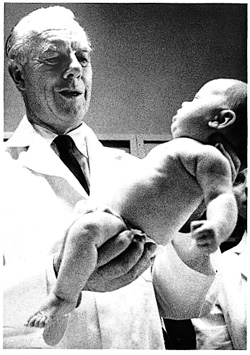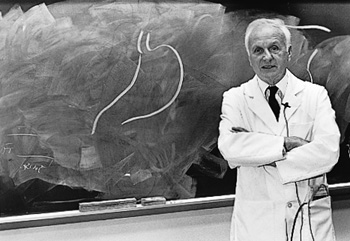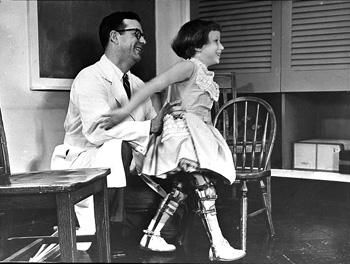
Dr. Amos U. Christie
Great teachers of VUSM

Dr. Jack Davies

Dr. J. William Hillman
“The Dynamic Duo”
Dr. Alfred Blalock (1899-1964)
VUSM faculty years (1925-1941)
Dr. Tinsley R. Harrison (1900-1978)
VUSM faculty years (1925-1941)
They are often called the “dynamic duo” of the early years of Vanderbilt University School of Medicine. Drs. Alfred Blalock and Tinsley Harrison were roommates at Johns Hopkins and came to Vanderbilt in 1925 as the first chief residents in Surgery and Medicine. Blalock is known for his pioneering research on the nature and treatment of hemorrhagic and traumatic shock, and is credited with saving the lives of many casualties during World War II, and with the first open heart operation for tetralogy of Fallot (blue baby). But his teaching techniques also set him apart.
“He was entirely dedicated to the education of students and residents,” says Dr. Walter H. Merrill, professor of Cardiac and Thoracic Surgery at VUMC. “He talked a lot over the years about his real joy in life – working with residents. He liked to give positive reinforcement. He was courtly and courteous.”
Harrison, characterized as a “human dynamo” by Dean Canby Robinson, was the author of Harrison’s Principles of Internal Medicine, one of the major textbooks in internal medicine. His lectures were “exciting,” according to a tribute written by the late Dr. Addison B. Scoville Jr. of VUMC.
“He made heart sounds come alive. The ‘lub-dub’ he mimicked was accentuated by screeches and whistles so that you could actually visualize the heart valve puckering up or opening wide…He would not make a correct diagnosis on rounds. He would send us scurrying to the library to prove he was wrong. Invariably we found out he had a method to his madness and this was a superb way of getting us to know the library and making us think.”
Dr. Thomas E. Brittingham
(1924-1986)
VUSM faculty years (1963-1980)
The key to the success of Dr. Thomas Brittingham’s teaching wasn’t as much what he taught but how he taught it, said Dr. John S. Sergent, MD’66, HS’70,’71, now professor of Medicine and chief medical officer of the Vanderbilt Medical Group.
“His success was in the way he taught and the challenge he threw down to us, to always be skeptical, to follow our own instincts and to really get to know our patients,” Sergent said.
His Saturday morning patient conferences for third-year students are legendary.
“He would invariably work up the patient far better than we did, sometimes going to extraordinary extremes,” said Sergent, the first recipient of Vanderbilt’s Brittingham Award for clinical teaching. He might call a grandparent or go to another hospital and look up medical records.
“You felt like you were working in a goldfish bowl when you worked with Dr. Brittingham,” Sergent said. “He created an environment so detailed in his knowledge of his patients, that he made everybody try to rise to that level.”
Brittingham, who kept a framed letter on his wall from the Dean of Harvard Medical School telling him his career was in jeopardy, rarely took vacations, made house calls, and gave his patients his home phone number. “I knew him to buy firewood and help out with the rent for two of his patients,” Sergent said.
Dr. Barney Brooks (1884-1952)
VUSM faculty years (1925-1951)
There’s an urban legend about the surgical rounds of Dr. Barney Brooks that’s often told to medical school classes. It may not be true but the story adequately represents the effect he had on students.
Brooks, in his intimidating, jerky voice, supposedly asked a third-year student, called down from his seat during one of Brooks’ Tuesday morning amphitheater clinics, what type of diet to recommend for a patient unable to absorb foods. The student replied “sweet potatoes,” only to have the bald-headed, grimacing Brooks scream back in his face, “sweet potatoes?!” The student reportedly fainted.
“He was admired. Not everybody loved him, but he had everybody’s respect. He taught in a very structured, strict and authoritative manner. Students were in awe of him, but they were somewhat fearful of his presence,” says Dr. Irwin B. Eskind, MD’48, HS’51. Brooks loved talking with patients during his teaching rounds. Farmers and farmer’s wives were among his favorite patients. He sometimes spent class time discussing farm life, crops or the weather with the patient.
When Dr. Harris D. Riley, Jr., MD’48, HS’50, professor of Pediatrics, was a third-year student, Brooks told one of Riley’s patients that he would need surgery the following morning. The patient told Brooks he would have to obtain the permission of his physician, Dr. Riley. Brooks called a terrified Riley, who was convinced his medical career was over, into a student laboratory. Instead Brooks told Riley, “I am deeply gratified at what we have just witnessed. That a student has established such a relationship with his patient pleases me greatly.” Riley said he recalls little after those two sentences.
Dr. Amos U. Christie (1902-1986)
VUSM faculty years (1943-1986)
Dr. Amos Christie may be best known for his research in histoplasmosis but he’s also fondly remembered at VUSM for his unorthodox teaching practices. He rarely used lectures, never quite finished his sentences and didn’t really worry about whether he pronounced his words correctly. But he taught students to be consummate clinicians, compassionate, and knowledgeable in all areas of pediatrics.
“He taught us by example that to weep over a dying child is acceptable no matter how big or tough we may think we are,” said Dr. Robert Merrill, MD’49, HS’49,’50,’53,’54. “He taught us to blame red eyes and moisture on the common cold. Some of us still do that.”
Christie is known for integrating the Vanderbilt Hospital children’s ward five years before the U. S. Supreme Court made it mandatory.
“It was done in the interest of patient care. There was no committee, no permission granted, no authority vested and no publicity. It was just done by executive decree. I call that administration.”
Dr. Jack Davies (1919-1991)
VUSM faculty years (1963-1989)
Dr. Jack Davies once said this about teaching: “I want it to be fun. If it’s not fun, it’s no good. I think teaching is a gift…I learn something every time, every day.”
Dr. Jeanette J. Norden, professor of Cell Biology and a colleague and friend of the former professor and chair of anatomy, said Davies was “one of a kind.”
Davies had an outrageous sense of humor, knew Greek and Latin, was well versed in the classics and had an outstanding artistic ability. He could draw with both hands. He had an “unbelievable knowledge of how the body was put together,” Norden says.
“Most of all, he loved students. He loved gross anatomy and knew how to communicate both the knowledge and his love of the subject to the students in a real and meaningful way. He could take students and teach them the wonders of the human body with enthusiasm and awe, year after year.
Dr. James R. Dawson Jr.
(1908-1986)
VUSM faculty years (1938-1949)
Dr. James R. Dawson, who taught the school’s second-year pathology course, endeared himself to students by his bluntness, said Dr. Fred Allison, MD’46, HS’46.
“He was very quick to say what he thought and if he told you something, he expected you to remember it,” Allison said. “He didn’t call on students very much, but if he did, you’d better hope you knew the answer to his question.”
Dawson left Vanderbilt in 1949 to become professor and chair of Pathology at the University of Minnesota. He was influenced during his early years at Vanderbilt by Dr. Ernest T. Goodpasture and developed a strong interest in virology, especially viral diseases of the central nervous system.
“Behind all of that fierceness, he was a hard working, wonderful person with a great sense of humor. He was very current and knew the research literature. He genuinely liked medical students. He scared you to death in class, but when class was over, he was a different person, smiling and joking with you.”
Dr. J. William Hillman (1921-1970)
VUSM faculty years (1952-1970)
Dr. J. William Hillman had a “genuine interest” in his patients, a trait that was transmitted to students and residents, said Dr. Robert D. Collins, John L. Shapiro professor of Pathology.
“He was committed to his patients’ welfare. He showed students and residents how it was possible for an individual doctor to make a difference in people’s lives,” Collins said.
Hillman was relentless in his work ethic. Within six years of his arrival at Vanderbilt, he had become professor and head of orthopaedics, then a section of general surgery. In 1962, he convinced Dean John W. Patterson to establish an autonomous Department of Orthopaedics and Rehabilitation. After his death, students developed the Hillman Award, a teaching award, given to a member of the housestaff with the greatest interest in the education of medical students.
Chancellor Alexander Heard once called Hillman “a premier member of the Vanderbilt faculty . . . We had none better and I know of no one who gave more of his life selflessly and without limit to help others.”
Dr. Rudolph H. Kampmeier
(1898-1990)
VUSM faculty years (1936-1963)
World War II took its toll on Vanderbilt’s Department of Medicine in the early 1940s. Dr. Rudolph H. Kampmeier, by himself, held it together while all other faculty members were serving their country during the war.
“He was able to effectively use friendships with practitioners in Nashville to keep the department running,” Collins said.
Kampmeier, who taught the physical diagnosis course for second-year students, was well known for his ability to get information from a patient and how to analyze what the information meant. He also excelled at the dynamics of physical examinations and patient histories. “He routinely figured out where and what the problems were by palpation or auscultation,” Collins said.
“Dr. Kampmeier was the master of the patient history, of getting information that is often locked inside the patient.”
Chancellor Emeritus Harvie Branscomb said that Kampmeier’s “warm and friendly spirit” made it a privilege to know him. “For Rudy Kampmeier, medicine was more than a career, it was a vocation he served with unflagging devotion.”
Dr. Barton McSwain (1906-1981)
VUSM faculty years (1946-1981)
Dr. Barton McSwain, MD’30, was an expert in surgical pathology and knew the human body like few others. But what set McSwain apart from other experts in pathology was that he had enormous clinical experience.
McSwain, the third of four generations to graduate from VUSM, taught the surgical pathology course to third-year medical students and was well known for his energy. He delivered a once-a-week, three-hour lecture in a 55-seat lecture hall with no break.
“He would talk without notes,” Collins said. He had a well-organized presentation of disease from the standpoint of surgery. His presentations were lucid and well organized. He could pull together enormous amounts of new material as well as provide reinforcement for the material the students learned as second-year pathology students.”
Dr. John L. Shapiro (1915-1983)
VUSM faculty years (1948-1980)
Dr. Clifton K. Meador, MD’55, HS’59, believes that Dr. John L. Shapiro scared students into learning.
“It was awesome. He taught by complete fear. It was the most effective use of the technique I’ve ever seen. He genuinely wanted you to learn the material and if you didn’t, he would tell you about it.
Meador said that Shapiro, who was appointed professor and chairman of the Department of Pathology in 1956, was known to curse, shake his head, stamp his feet or just leave the classroom in disgust if a question was answered wrong in his second-year pathology course.
“He wasn’t acting. He was truly disgusted. Sometimes I think he was really mad at himself for not getting through to you.
“You were terrified of him, yet you weren’t. You wanted to please him more than anything. I had enormous respect for this man.”
Meador said that a legendary Shapiro story tells of a medical student who lost all 20 feet of intestine while washing it in a sink. “What am I going to tell the old SOB,” the student asked, not knowing that Shapiro had just entered the room. “I’m not old,” Shapiro told the shocked student.













